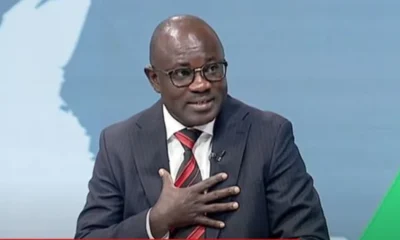Democrats, in Begala’s view,
should do all they can to reduce their losses among high-school educated, rural and exurban voters, but with Dems solidifying their hold on the rising American electorate (people of color, younger voters and unmarried women), adding college-educated whites would make the Democrats dominant.
In this political climate, Begala continued, the best thing a Democratic presidential candidate can do is
tell voters that Trump has proposed hundreds of billions of dollars in cuts to Medicaid, Medicare, and Social Security. I did not hear one candidate raise that in the last Democratic debate, but it is the issue most likely to defeat Trump.
Fred Wertheimer, the founder and president of the campaign finance reform advocacy group Democracy 21 and an adviser to the House Democratic leadership on impeachment, notes that if Democrats win the presidency, they will no longer have “uniform opposition to Trump as their organizing principle.” In those circumstances, “they will need a president with a program to avoid constant policy arguments,” he said, adding “I doubt they will overreach with a left agenda.”
Matt Grossmann, a professor of political science at Michigan State, pointed out that
the last two Democratic presidents have had large agendas and attempted to move policy substantially leftward across issue areas, resulting in public opinion moving in a conservative direction in response and contributing to historic midterm losses in 1994 and 2010.
The next Democratic president, he continued,
will face pressure to make large-scale changes in health care and the environment and to address numerous issues of importance to the party’s myriad constituencies.” But no matter what a prospective Democratic administration does, it “will likely generate a conservative backlash either way.
In one of the more interesting essays on the danger of Democratic overreach, “Left-Wing Policies Aren’t Risky for Democrats. Unpopular Ones Are,” Eric Levitz, a senior writer for New York Magazine, made the case that:
There is no tight correlation between a policy’s ideological extremity — as judged by its distance from status quo policy or the dictates of political theory — and its electoral viability. Many “far left” ideas are broadly popular (e.g., installing workers’ representatives on corporate boards, soaking the rich, giving federal jobs to all the unemployed), while some “centrist” ones are politically toxic (“entitlement reform,” the individual mandate for health insurance).
Within this context, Levitz writes, there are
some aspects of progressive ideology that put the left in perpetual tension with majoritarian intuitions. The left exists to oppose arbitrary hierarchy and champion those who are oppressed and exploited by the status quo social order.
What this constant tension suggests, in Levitz’s view, is
that the left can’t presume its moral truths are self-evident to the 99 percent it claims to champion, or the 50-plus percent of voters whose support it aims to win.
Instead, he writes:
If progressives wish to maximize their near-term power, then their electoral strategy must account for majoritarian sentiment. Which is to say, it must be formulated around unsentimental answers to questions like: Where are voters with us, and where are they against us? What is the probability of changing the public’s mind on [unpopular policy x] within the duration of a single election cycle (i.e. time is the public’s opposition to our stance)? How salient is [unpopular policy x] with swing constituencies? Is there a way to mitigate the electoral detriment of [unpopular policy x] without abandoning our commitment to advancing that goal?
Levitz describes the strategies it might take for the Democrats to stay in power, if they win full control of the government, a counterpoint to the often-repeated contention that demographics will inevitably put Democrats in power.
In that context, Marc Hetherington, a political scientist at the University of North Carolina, wrote:
For about 20 years, Democratic strategists have been arguing that demographic change will soon provide Democrats a durable advantage. They failed to foresee the force of the white backlash against these demographic trends.
Trump, Hetherington continued,
might well be the last Republican who can win a national election by exploiting race the way he has. But political parties are sophisticated organizations that can and do make strategic adjustments when they need to.
I came back to Stan Greenberg with a few questions. He remains firm in his conviction that “these are different times.” First of all, he says, the Republican Party is shrinking. Trump has driven “McCain conservatives and socially liberal moderates” out, Greenberg said, leaving “a shattered party that will have trouble mounting opposition to the new president and agenda.”
On the left, Greenberg argues, there is
the unity of liberals and moderate Democrats on issues. Democracy Corps released a memo which showed what an extraordinary number of moderates wanted to tax the rich, for government to play a big role in health care, and address the big gender and race gaps.
Greenberg also asked rhetorically:
Do you really think the Democratic nominee is going to be running on Medicare for All and do you really think that will be the dominant health care filter when the president is running on abolishing protections for pre-existing conditions and failed to rein in prescription drug costs?
In conclusion, he put the situation this way:
Look at the change in the country in the proportion who believe there is an unfinished agenda for women and African Americans. A sizable majority believe that — and particularly true for all Democrats and millennials.
Recent history has shown regular swings back and forth from left to right. Both Democrats and Republicans have repeatedly demonstrated a capacity to self-destruct, but also to reinvent themselves. If Democrats are lucky enough to sweep the elections in 2020, they will face an enormous challenge: maintaining internal cohesion while retaining sustained public support.
This challenge has proved insurmountable in the past and it may well continue to feel that way — until it is, once again, surmounted.

 General News1 week ago
General News1 week ago
 General News4 days ago
General News4 days ago
 General News2 days ago
General News2 days ago
 Politics4 days ago
Politics4 days ago





